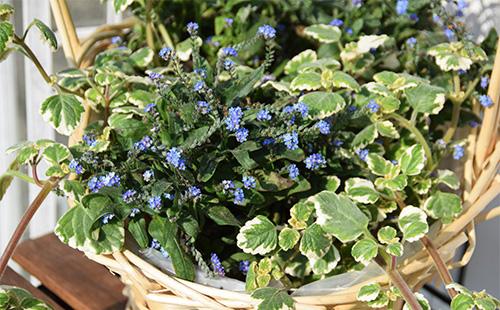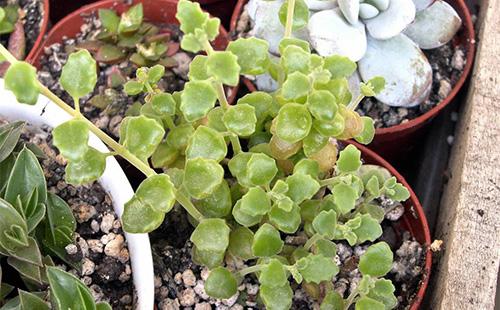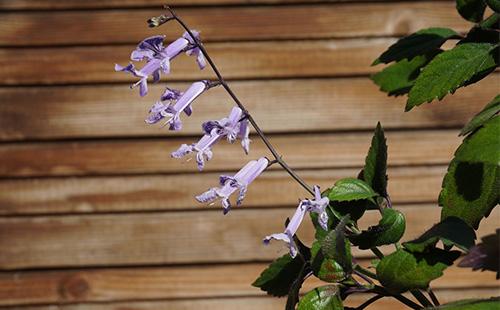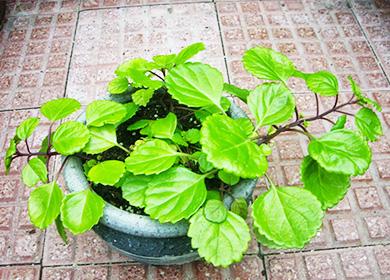The content of the article
Plectrantus is a plant almost fabulous: the banks of the Limpopo River are considered its homeland. Remember the cartoon of the same name based on the works of Korney Chukovsky? An evergreen shrub was discovered in South Africa, and after almost instantly spread to other eastern countries, such as Malaysia, India and Japan. Today, the cultivation of plectrantus (room mint) at home is a commonplace phenomenon. You won’t surprise anyone with a molar tree in a pot. However, this flower has not become less popular. The secret lies in its “multifunctionality”, which other indoor plants cannot boast of.
Mint is not grown for flowers, but for leaves. Attractive inflorescences of plectrantus can be called only with a big stretch. But the leaves of the same shape and size with which the stems of the shrub are strewn with are really worthy of attention. Most beautifully, the molar tree looks like an ampel plant living in a hanging planter.
Types of room mint
Plectranthus are shrubs and shrubs that can be distinguished not only in appearance, but also in leaf aroma. The leaves of the bushes smell of grass, and the shrubs popular in home gardening are mint. Among the most common types of molar tree, four are described, described in the table.
Table - The main types of plectrantus and their distinctive features
| View | Features |
|---|---|
| Koleusovidny | - Large leaves 6 cm long; - milk rim and milk stains on a leaf plate; - visually very similar to the famous coleus indoor flower |
| Shrubby | - Leaves wrinkled monophonic, heart-shaped; - large size of the sheet plate; - reacts to touch with the release of essential oils |
| Ertendahl | - Leaves are carved; - the top of the leaf plate is pink and the bottom is green; - smells of camphor; - Needs constant pinching; - possesses the best among plelectrans decorative qualities |
| Felt | - Leaves are carved; - shoots of a drooping type; - it smells slightly of mint; - the leaf plate and stems are covered with hairs; - needs a lot of sunlight |
Proper Plectrant Care
After buying a plectranthus in a pot, it is based on the principle of creating conditions for a flower similar to its native subtropical climate: sufficient humidity, plenty of sunlight and warm air.
Choose a location and light
An ideal location for the plectrantus is considered to be the windowsill of the window looking southwest.Having settled in this place of an apartment or house, the evergreen shrub will be fully provided with diffused sunlight. Under direct sunlight, indoor mint can not be substituted. Prolonged and continuous exposure to ultraviolet light on the stems will cause the plectrantus to turn yellow and fall off the leaves. Therefore, lighting should be plentiful, but scattered.
Gray
The subtropical plant feels comfortable at our traditional room temperature from 20 ° C to 25 ° C. In winter, an evergreen shrub is ready to accept the fluctuation of the temperature range from 16 ° C to 19 ° C. But if the temperature drops below the indicated minimum, the plectrantus will instantly discard the leaf and remain naked.
Water and moisturize
Plectrantus loves moisture no less than sunlight. In summer, the ampelous flower grows intensively. So, it quickly spends its moisture reserves. Starting in mid-spring, when the room temperature rises above 22 ° C, it is necessary to increase the frequency of irrigation of the shrub and spray once a day with standing water. In the frosty season, water the plectrantus (indoor mint) should be every four days.
Preparing the ground
Soil intended for growing a molar tree should have a low density. The subtropical plant loves the “airy” land and appreciates it when the grower does not forget about aeration. There are five main ingredients of the plectrantus substrate:
- humus - one part;
- soddy soil - one part;
- leaf soil - one part;
- river sand - 0.5 parts;
- peat - 0.5 parts.
We feed
During dormancy (autumn and winter), the molar tree does not need to be fed. To apply fertilizer is relevant only in the warm season, from April to August. That is, when the plant begins a period of active growth. Plectrantus will have enough fertilizer for decorative indoor plants. If possible, mineral infusion should be alternated with organic, using one of the agents every two weeks.
We transplant
You will have the first transplant immediately, as soon as you bring mint from the store home. For the first time, you should carefully remove the plant from the container, without separating the root system from the lump of earth, and in exactly the same form, place the removed contents in a larger pot. Next, the plectrantus is transplanted once a year, in the spring. Plants older than five years old are transplanted on demand - that is, when the root system becomes larger than the capacity allocated for it.
Remove flowers
Almost all beginner gardeners are interested in the question of how to care for the plectrantus during flowering, and how, in fact, it blooms. The inflorescences of these evergreen shrubs are the same. They can be of several colors: white, cream or dull lilac. The shape of the inflorescences is umbrella. Experienced flower growers in their reviews recommend picking off a flower stalk so that the plant does not expend energy and energy on flowering.

We cut and pinch
Pinching the young tops of the plectrantus is a prerequisite for the formation of a lush decorative shrub. Moreover, the more often you do this, the more beautiful the “paws” of the molar tree hanging from the pots will be. Correctly cut the plectrantus is easy. To do this, select weak and leafless shoots, and then shorten them exactly half.
3 ways to propagate a molar tree
Plectrantus can be propagated by cuttings, seeds or dividing the bush. All methods are easy to implement and quite effective. 96% of planting material take root in a separate pot without any problems.
Cuttings
Features Interestingly, sometimes even leaves can play the role of cuttings. Only healthy and intact. To propagate the plectrantus by cuttings, follow the algorithm described below.
Action algorithm
- Trim the tops.
- Dip in a glass of water (if a sheet is used, then the sheet plate should not touch the water).
- We are waiting for the roots.
- We plant in a pot of soil.
Bush division
Features The method of propagation of room mint by dividing the bush can be used in the process of annual plant transplantation. Separated from the rhizome of the mother flower, the "children" can be immediately planted in separate pots with a substrate prepared in advance or purchased in the store. It is recommended to share a plant with a developed root system.
Action algorithm
- We take the plectrantus out of the pot and gently shake the ground from the rhizome.
- Using a sharp kitchen knife, divide the rhizome.
- Sprinkle slices with crushed activated carbon to protect against decay.
- We transplant new fragments into separate containers.
- Moisten the substrate slightly and take care as usual.

Seed planting
Features Seeds for seedlings are best purchased at the store. The best time for landing is April-May. When adopting this method, keep in mind that room mint seeds can germinate accurately in the temperature range from 20 ° C to 24 ° C, so they are never sprinkled with earth when planting.
Action algorithm
- We sow seeds, scattering them on the surface of the soil, and gently squeeze each seed into the soil.
- A week later, as soon as the seeds sprout, we begin moderate watering.
- After four to five weeks, transplant the seedlings into separate containers.
Growing problems
Most diseases affecting the plectrantus occur due to the fault of the grower. Overfilled, underfilled, froze, forgot to feed. All wrong actions committed in relation to a flower can affect his health and have visible consequences. The table shows the most common problems that flower growers encounter in the process of growing a molar tree.
Table - Plectrant Diseases from Improper Care
| Disease | Cause | Treatment |
|---|---|---|
| The leaf turns yellow and falls, the plant does not bloom | - Cold | - Get a room temperature suitable for the plant |
| Rot at the base of the root | - Waterlogging; - cold; - excessive watering | - Remove the rotten root fragments, capturing 2 cm of healthy roots; - in case of severe damage, remove the plant from the house and boil the container in which it was contained, since it will not be possible to save the flower |
| Lethargy of leaves and stems | - Water scarcity | - Stabilize your watering schedule |
| Unhealthy Light Green Leaves | - Sunburn | - Remove the plant from direct sunlight |
| Appearance of gray spots on foliage | - Powdery mildew; - overflow plants | - Spray the plant with a whey solution (100 g of whey per glass of water) |

Pests
Pests rarely infect the plectrantus, however, when they appear, they can significantly harm it. There are two reasons for the reproduction of insects on the leaves of a molar tree. The first is the dry air in the room. The second - infection from flowers growing in neighboring pots, or from bouquets that were brought into the house from the street and put in a vase. What to do with pests, the table will prompt.
Table - Pests of room mint and how to deal with them
| Pest | Manifestations | Fight method |
|---|---|---|
| Spider mite | - A spider web appears on the back of the leaves | - Cover the soil with polyethylene and thoroughly rinse the flower under the shower, washing off insects on both sides of the leaves; - if it doesn’t help, it is necessary to treat indoor mint with insecticides |
| Aphid | - On the back of the leaves and stems there is an accumulation of small light green translucent insects | |
| Shield | - The stalks of plectrantus are covered with brown growths | |
| Whitefly | - On the back of the leaves there is an accumulation of small white insects with wings |
The leaves of some species of mint look like coins. Perhaps that is why many superstitions are associated with plectrantus. It is believed that this indoor flower is able to attract cash flow into the house. And a person who knows how to care for a plectrantus and watered a money tree, supposedly, grows his financial independence in this way. The smell of a mole tree, which people like so much, categorically does not tolerate mosquitoes. And the moth will never touch the fur coat, in the pocket of which lies a bag with dried foliage of this domestic flower.
Reviews: “I plant at least 5 pieces in one pot so that the greens look more magnificent”
I also pruned, and then there was no time, I left .... in short, I now have a huge bush, and I have 8 stems that stretched so centimeters 60 up)))) I pruned one - planted it (I didn’t root it, I immediately planted it in the soil, and didn’t cover anything - started), brought it to work, I’ll form a new bush.
Tatyana, http: //xn—90abeg5aqc2a7a.xn—p1ai/2014/07/%D0%BA%D0%BE%D0%BC%D0%BD%D0%B0%D1%82%D0%BD%D0%B0%D1 % 8F-% D0% BC% D1% 8F% D1% 82% D0% B0-% D0% BF% D0% BB% D0% B5% D0% BA% D1% 82% D1% 80% D0% B0% D0 % BD% D1% 82% D1% 83% D1% 81-% D0% B0% D1% 80% D0% BE% D0% BC% D0% B0% D1% 82% D0% BD% D1% 8B /
This plant appeared in our house more than ten years ago, it was brought by mother from relatives from the Urals. She was praised as an effective way to fight moths: these insects are supposedly scared away by the aroma of the plant. How the mole reacts to plectrantus, I do not know, have not seen. But the flies are definitely not afraid of him: she watched as they quietly crawled along the leaves. Plectrantus has a specific aroma, similar to a mixture of mint with some kind of medical warming ointment. The smell comes from touching leaves and stems. Sometimes I wash off the dust from the leaves (they are not smooth, slightly pubescent, easily break off) in the shower, after which the whole room is filled with this aroma for half an hour.
If you do not trim the apex, the plectrantus can stretch out half a window. After trimming starts branching. It grows very fast. I renew the plectrantus completely every six months, maximum a year: I cut off the tops with 3-5 leaves and put in water until they give root. You can immediately stick into the damp, loose earth - they also take root well, the main thing is to stick the stem slowly so as not to break. Plectaranthus may not be renewed so often, but I do not like it when its stem is covered with a thin brown-beige crust. When the plant loses, in my opinion, an aesthetic appearance, I cut off the tops for rooting, throw out the stalk with roots, and lay out the broken leaves on the shelves in the bathroom and toilet (for aromatization and decoration - they do not fade even the plucked ones for 2-3 days, but keep the green color for at least two weeks, dust also lingers on them), after a couple of weeks I collect them and also throw them away. Pots can be used without holes and without drainage, since the roots are thin, long and there are a lot of them, they completely braid the earth and drink decently especially during the growth period. I prefer to plant at least 5 pieces in one pot so that the greens look more magnificent. Plectrantus does not like the bright sun - the leaves are smaller, but in the shade it stretches out, losing its shape. My plectrantus never bloomed, but I read that it sometimes blooms with small blue inflorescences.
Hope66, https://irecommend.ru/content/bystro-rastet-aromatiziruet-pomeshchenie-i-vozmozhno-otpugivaet-mol
When it appeared, it struck not only me with its aroma. It is better to keep in the kitchen or in rooms where no one sleeps, because it can easily cause a severe headache, especially if there are other factors of its appearance (for example, barking of a dog, etc.). It also has a destructive effect on some insects, but not on all (flies calmly fly in his presence and those who emerged from the earth). Perhaps they are still fewer.I have a terry variety, quite decorative for about 5 years, then you can leave only young shoots and root. If a lot of shoots can be planted without sparing, directly into the ground - the strongest will survive, which is good for the future plant. Will replace geraniumif she’s tired. Does not bloom. There is a terry and smooth sheet.
Irina, http://otzovik.com/review_4442373.html

